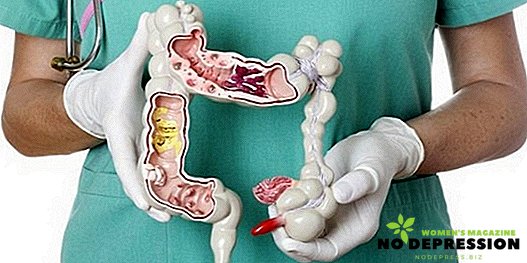It has been scientifically proven that a harmless polyp can develop into a malignant neoplasm. Therefore, the close attention of physicians is paid to the diagnosis and timely treatment of polyposis.

What are polyps, how are they formed?
Polyp is a protrusion of the mucous membrane into the lumen of a hollow organ, which is abnormal in nature.
It is formed due to impaired physiological cell renewal. Normally, the surface layer is updated constantly.
As a result of an uneven process of changing the cellular composition, a local outgrowth is formed in the intestine above the mucous layer.
Types of polyps and their causes
One of the main reasons for the formation of a polyp is hereditary predisposition. Adverse factors that may be the launching point for disruption of mucosal cells change also include:
- Foods that contain large amounts of animal fat;

- Insufficient fiber intake;
- Hypodynamia (sedentary lifestyle);
- Inflammatory bowel disease;
- Regular constipation.
A diet with a predominance of fatty and smoked food, as well as a high content of preservatives causes the formation in the gastrointestinal tract of a large number of carcinogens. Long and frequent constipation ensures a long stay of these substances in the intestines and their effects on the mucous membrane.
It is carcinogens that lead to impaired physiological repair (cell repair).
There are several classifications of polyps:
- Depending on the amount - single form, plural form, diffuse form;
- Depending on the morphological structure - glandular, villous, glandular-villous, juvenile, hyperplastic, fibrous.
What complications is a rectal polyp?
Of particular interest to the problem of the formation of polyps is caused by their transformation into a malignant tumor. It is proved that in almost seventy percent of cases, rectal cancer is formed from a polyp.
The most disturbing are the multiple and diffuse forms, which are often family-related. Polyposis is an obligate precancer. That is, in almost all cases, a malignant neoplasm occurs.

The first symptoms and signs of rectal polyps
The clinical picture of polyps due to their number, size, histological structure. Small education does not bother a person. Usually detected by chance when carrying out diagnostic activities for another disease or routine examination.
Large-sized polyps, as well as multiple, give a feeling of discomfort in the abdomen or finding a foreign body.
Sometimes it is possible to detect blood on the stool. Patients may complain about the difficulty of the act of defecation, if the education has reached a considerable size.
Diagnosis of polyps in the rectum
The diagnosis of a polyp is set on the basis of clinical, laboratory and instrumental data. The doctor at the reception is conducting a study of the rectum, which can detect bleeding, local formations.
Laboratory diagnostics aims to detect blood in the feces, the so-called hemocult test. With the help of it even a small amount of blood is detected.
Instrumental research methods include:
- Irrigoscopy (radiopaque);
- Rectoromanoscopy (endoscopic);
- Colonoscopy (endoscopic).

Irrigoscopy is an x-ray method for examining the intestines. The essence of the method is the introduction of a contrast agent with an enema.
The contrast gradually fills the entire intestine, and after a while the results are evaluated. Thanks to this method, a specialist can detect an intestinal filling defect, which makes it possible to suspect a pathological mass.
Rectoromanoscopy allows visualization of the entire rectum and part of the sigmoid with a special optical device.
Also during the sigmoidoscopy can immediately remove the formation, if it has a small size.
Colonoscopy also refers to the endoscopic method of research, however, in contrast to sigmoidoscopy, in this case, the state of the entire colon is assessed, therefore, its diagnostic significance increases. However, it requires more preparation before the study.

Why is it important to know the histological structure of a polyp?
Some types of polyps much more often and more quickly develop into a malignant neoplasm than others. For example, the villous type is the most unfavorable in this respect.
In what cases instrumental methods of research are shown?
Doctors determine the risk of cancer. Selection is based on the following criteria:
- burdened heredity;
- patient complaints;
- lifestyle of patients.
Under burdened heredity understand cases of bowel cancer in close relatives, familial polyposis.
To tentatively determine the age at which you want to start sigmoidoscopy / colonoscopy, you need to take ten years from a relative's age (when he was diagnosed with cancer).
For example, at 34 years old, rectal cancer was diagnosed. So the research, according to oncologists, should be started from the age of 24 and repeated every five years.
Why is it worth taking ten years exactly? The fact is that a polyp is converted to cancer in about that time.
Patient complaints occur when education reaches a sufficiently large size and requires urgent treatment.

Polyps treatment
Therapeutic tactics in detecting a polyp is aimed at its removal. There are methods of traditional and traditional medicine. The traditional is aimed at excision of the pathological site of tissue by surgical or endoscopic methods.
Folk remedies involve the use of medicinal plants. The most frequently offered are the following: celandine, calendula, yarrow, fruits of viburnum. They can be used both inside and in the form of enemas.
Treatment of folk remedies
One of the most popular means is celandine. With the help of his decoction (at the rate of one teaspoon per hundred and fifty ml of boiling water) you can make microclysters. Before the introduction of broth celandine in the rectum, it is recommended to insist it for forty minutes, as well as pre-make a cleansing enema.
 Cleansing enema is an important step in preparing for treatment with celandine, significantly improves the result. When setting the treatment of microclysters, it is recommended to change the position of the body: a few minutes on the left side, then roll over on the right side, on the back.
Cleansing enema is an important step in preparing for treatment with celandine, significantly improves the result. When setting the treatment of microclysters, it is recommended to change the position of the body: a few minutes on the left side, then roll over on the right side, on the back.
Treatment of celandine should be courses. One course is ten days. After each course, you must take a break during the week.
Also for the treatment of microclysters perfect collection of yarrow, calendula flowers and celandine. Preparing the infusion as follows:
- calendula, celandine and yarrow are taken at the rate of 2: 1: 1;
- one tablespoon of raw materials is poured 100 ml of boiling water;
Microclysters with the collection of medicinal herbs put after a bowel movement or previously held cleansing enema. The course of treatment is ten to fourteen days.
Traditional medicine recommends the use of the decoction of the fruit of viburnum. You need to drink it three or four times a day. The beneficial properties of viburnum fruit are aimed at preventing the growth of a polyp.

Polyp surgery
Preoperative preparation includes a cleansing or siphon enema. To date, proposed various drugs that help cleanse the intestines. They are more convenient for the patient, equivalent in effectiveness to siphon enema.
There are several ways to remove rectal polyps:
- endoscopic;
- surgical.
The endoscopic method involves the removal of small growths using electro excision. Electro excision is the method of tissue excision by electrocautery.
Formations of sufficiently large size are removed in parts.

The surgical method involves the removal of the part of the intestine affected by the pathological process. Most often, this tactic is suggested for polyposis.
Endoscopic removal of a polyp has several advantages over surgery:
- minimally invasive;
- short hospital stay;
- fast recovery of intestinal tissue.
However, not all polyps can be removed by an endoscopic method. Especially if the intestine is affected over with formations of sufficiently large size. In this case, resort to surgical treatment of the patient.
All removed tissue sites are subject to histological examination in order to exclude a malignant tumor.
In the case of detection of cancer cells, the scope of the operation is greatly expanded.
After surgery to remove a polyp, relapse is possible. It usually occurs one to three years after the operation. Therefore, one year after treatment, you need to undergo a colonoscopy.

Prognosis and prevention of rectal polyps
The prognosis of rectal polyps depends on several factors:
- prescription of education;
- polyp size;
- quantities;
- hereditary factor.
The degeneration of polyps into a malignant neoplasm occurs in about ten years. The larger the size of polyps and their number, the higher the likelihood of their malignancy. The most dangerous is family polyposis, and cases of colorectal cancer in close relatives.

The preventive measures for the development of polyps include:
- healthy food, which provides for the regular inclusion in the diet of foods rich in coarse plant fiber;
- active lifestyle;
- rejection of bad habits;
- struggle with regular and long-term constipation;
- Regular (once every five years) colonoscopy if you are at risk.
For more information about polyps, see the following video.













